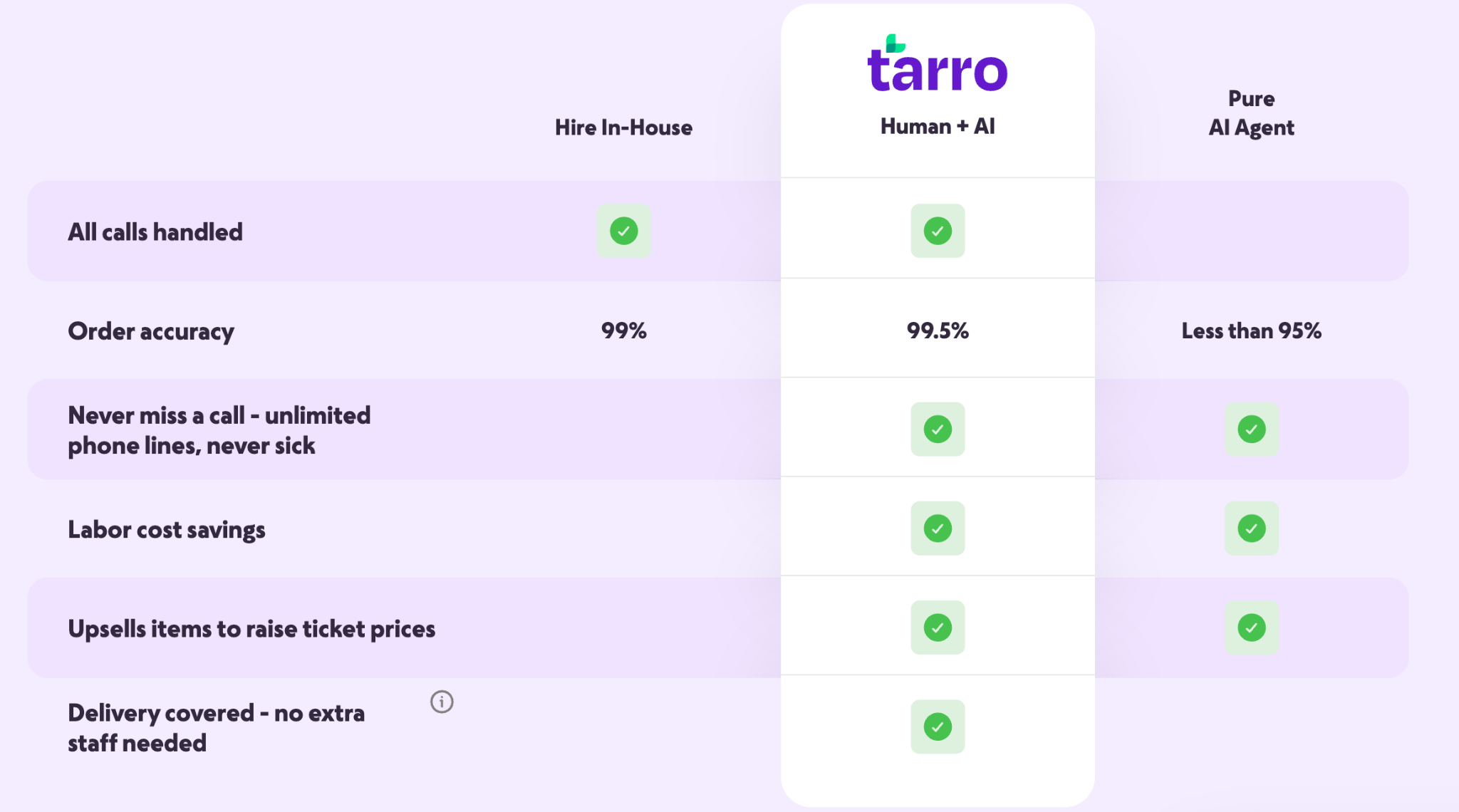Restaurant Phone Ordering Service in 2025: Human vs. AI vs. Human+ AI
October 3, 2025
Compare human, AI, and Human+AI phone ordering for restaurants. See how Tarro reaches 99.5% accuracy and grows sales 5-20% with Human+AI phone ordering system.


Since 2019, labor costs have jumped 18.3%, while staffing has become harder than ever. This forces restaurant owners to find ways to reduce labor costs.
In restaurant operations, phone answering is the most logical first step for outsourced automation. Here's why:
Cost Impact:
Front desk workers earn $15-20/hour (depending on the state) with high turnover rates. Recruiting, training, and retaining them adds ongoing costs and instability.
Operational Chaos
Phone ordering is complex and demanding – handling custom requests, modifications, and detailed menu items requires high accuracy. Constant ringing interrupts counter service, food prep, and other front-desk tasks, creating friction across operations.
Revenue Risk:
Phone orders are the primary revenue driver for takeout restaurants, often accounting for more than 50% of total orders. Just imagine: Each missed call costs around $20-50 in lost orders; each mistake requires expensive remakes, which directly impact revenue.
That's where AI comes in as a powerful enabler: it never calls in sick and costs a fraction of human wages.
But here's the problem: early AI adopters are seeing mixed results. Some restaurants report major wins, while others face customer complaints and order disasters.
This creates an urgent question every restaurant owner must answer: Should they stick with expensive human staff? Risk everything on unproven AI? Or find a middle ground?
In this article, we'll use 13 years of restaurant technology experience to solve this puzzle: Which approach actually works best for restaurants?
By the end, you'll learn:
- The pros and cons of human-only, AI-only, and Human + AI models
- Why a Human + AI phone ordering system delivers the best mix of speed, accuracy, and quality customer service
- How Tarro helps restaurants reach up to 99.5% phone order accuracy, cut costs, and grow sales by 5–20%
Phone answering service for restaurants
For restaurant owners looking for the best phone answering service for restaurants, the choice often comes down to human, AI, or Human+AI solution
The Three Main Approaches to Restaurant Phone Ordering Service in 2025
Human-Only: Hire Your Own Staff
Rely on staff or owners themselves to answer phones and take down orders. Simple and personal, but also unreliable. As it relates to staff, late callouts, unexpected churn, or even personal mood can lead to poor customer experiences and a negative impact on your business.
AI-Only: Pure Technology Solutions
Automated systems handle every call, from order-taking to payments. Fast and low-cost, but not great at delivering a quality customer experience. Since customers naturally prefer talking to humans and humans are naturally better at producing a great, consistent customer experience.
Human + AI: The Combined Approach
Humans answer all calls, enabling customers to have a smooth ordering experience while upsells, reservations, and other requests are completed. AI acts as the co-pilot, enabling better speed, accuracy, consistency, and an overall great customer experience.
So which approach is actually right for YOUR restaurant?
Before we compare these three options, we need to understand the real problem. What challenges do restaurant owners face with phone orders today?
What Problem Are Restaurant Owners Really Trying to Solve?
After working with over 3,000 restaurant partners, we’ve talked to many owners. Their concerns are very similar. Phone ordering isn't just about answering calls.
It affects order accuracy, how much things cost, how much money they make, how many negative reviews and complaints they receive, and how stable their business runs.
Now that we understand what's at stake, let's see how each approach handles these challenges.
Human vs AI vs Human+AI Phone Ordering: Comparison for Restaurants

This comparison shows clear differences between the three approaches. But numbers alone don't tell the whole story.
Let’s first look at the traditional Human-Only approach and the newer AI-Only option – who they fit, and where each falls short.
Human-Only: Trusted, but Too Expensive
Human-Only systems can make sense when:
- You’re in an area with poor or unstable internet, so tech tools aren’t reliable.
- You have low call volume (under 10 calls/day), and the person on the phone does other useful tasks.
- You run a family restaurant and like the personal touch of answering calls yourself, even if it means being tied to the phone.
That said, relying only on people has big downsides: higher labor costs, missed calls during rush, and uneven service quality across shifts.
- Long training time. Good accuracy needs experienced staff. It takes time and money to get new workers ready.
- Unreliable coverage. Humans can't work 24/7. During peak hours, calls get missed or customers wait on hold.
- High costs. Higher pay, workers leaving, and constant training make human-only systems too expensive to keep running.
These problems push some restaurants toward the opposite choice: using only AI. Yes, AI is trending. We all know it's cheap, fast, and can even talk to customers. But here's the catch: recent news shows that even big brands like McDonald's and Taco Bell have stopped using AI for drive-through orders. While their experiments were focused on drive-through ordering, the truth remains the same – pure AI order solutions simply can’t handle what restaurants need.
AI-Only: Fast, but Not Good Enough
AI-Only can work if:
- Phone orders are a small slice of your sales and volume is very low.
- Your staff can catch what AI misses, like delivery issues, complaints, or complex orders.
- Cost is the #1 goal, and you’re okay with trade-offs in service quality.
You might be thinking, “But big chains use AI for phone orders at huge scale.” True! some did run high-profile tests. But many later reported accuracy and customer-experience problems and changed course.
McDonald's test only reached about 80% accuracy. Repeated mistakes made customers angry. In one case, a customer asked for ice cream and somehow got bacon added. In another, the system added more than a hundred dollars worth of chicken nuggets. Taco Bell had its own viral "AI fails," including the famous prank order of 18,000 cups of water. This video went viral on social media, but for the restaurant chain, it was a disaster. McDonald’s and Taco Bell couldn’t make pure AI work and their menus are likely way simpler than yours.
The lesson: AI-Only can be fast and cheap, but it isn’t a fit for every menu, every accent, or every edge case.
So what exactly goes wrong when restaurants use only AI for phone orders? Let's take a closer look.
AI phone systems promise 24/7 service, instant replies, and lower worker costs (often 50–75% savings). But real-world use shows big limits:
- Misheard orders and errors. When AI doesn't understand, it can add wrong items, waste food, cause refunds, and hurt your brand. High-profile drive-thru tests showed weird, viral mistakes – like random toppings or huge joke orders – making brands pause or cancel tests.
- Accents, complex menus and background noise from caller. Different accents and even slightly more complicated menus make it harder for AI to understand. A small error can get much worse. For example, this actually happened during real phone orders: a customer says "salad," but the AI hears "channel" instead. The system then starts asking, "What kind of channel do you need?" and "Which channel would you like?" As you can see, when AI gets the wrong word, it starts asking questions that don't make sense, making the caller frustrated.
- Custom requests are common. Many phone orders include add/remove requests, spice levels, or allergy notes, just like online orders often have special instructions. AI can handle simple requests but struggles when the request needs personal attention or isn't clear. At best, when this happens, Pure AI systems will pass the order back to your restaurant/staff. At worst, a wrong order means your customer gets the wrong food, you get a bad review, and you lose that customer altogether.
AI-only can work for very basic orders. But when guests need changes or personal care, it falls short and customer loyalty drops.
This brings us to the solution that's winning in 2025: combining the best of both worlds.
Why Human+AI phone ordering works best for Restaurants in 2025?
A human + AI phone ordering system mixes the best of both worlds. Think of it as speed plus personal care, without having to choose between them. Here's why this mixed model is the best fit for restaurants:
What Humans Still Do Better
- Personal connection. They understand tone, show empathy, and build relationships with regular customers
- Handle complex requests. They can work through special dietary needs, complicated changes, and unusual situations
- Cultural understanding. They know local preferences, the pronunciation of menu items, and the cultural context
What AI Does Best
- Speed and coverage. Quick answers, no breaks, 7 days/week availability
- Quick order lookup & upsell Pulls up order history fast, quick lookup, identifies unclear customer requests and prompts the human taking the order with upselling opportunities.
- Labor cost savings
Human+AI The Best of Solution
Humans lead every call, ensuring smooth orders, upsells, and reservations. AI supports as a co-pilot, adding speed, accuracy, and consistency for a great overall experience. Restaurants get:
- Higher accuracy (fewer mistakes)
- Lower costs (fewer staff needed)
- Better customer experience (fast service with a personal touch)
- More reliable service (7 days/week coverage without quality loss).

Why Tarro Leads the Future of Restaurant Phone Ordering Service
So why does Tarro stand out in this space? Here's what makes the difference:
Much Higher Accuracy (up to 99.5%)
Tarro combines 13 years of phone ordering system knowledge with smart AI. When customers request "the combo with wings and ribs," our system can highlight key words, and suggest the most likely items from your menu, so the order is right the first time.
Maximum Flexibility
Unlike hourly staff, Tarro charges per order, automatically adjusting to your staffing needs, so you're never overpaying. This is especially valuable for new or expanding restaurants, where operations are still stabilizing. Tarro grows with you, so you can focus on getting your business off the ground while we handle the calls.
Smart Upsells That Feel Helpful
Tarro uses order history to suggest snacks or drinks and avoids repeating offers guests just said no to. A small increase goes far: moving from $25 per order to $30 across 30 orders per day can add about $4,500 per month. You can also set rules (like "Thursdays 12–3 pm suggest a specific dish") so offers fit your schedule and what you have in stock.
Seamless Service From Phone to Delivery
Many AI tools stop at the call. Tarro covers the whole process – phone and delivery, even without your own drivers. During busy times, orders go out faster, complaints often drop (up to about 50%), and you can reach up to 15 miles away, adding 5–20% more sales.
Tarro has been providing a phone ordering service for 13 years, serving over 3,000 restaurants with phone-order answering for takeout and delivery.
Ready to see how Tarro's human + AI phone ordering system can work for your restaurant? click below to schedule a one-on-one consultation.
